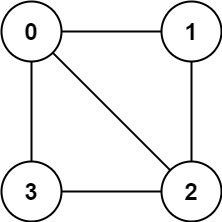dfs 785,803,
There is an undirected graph with n nodes, where each node is numbered between 0 and n - 1. You are given a 2D array graph, where graph[u] is an array of nodes that node u is adjacent to. More formally, for each v in graph[u], there is an undirected edge between node u and node v. The graph has the following properties:
- There are no self-edges (
graph[u]does not containu). - There are no parallel edges (
graph[u]does not contain duplicate values). - If
vis ingraph[u], thenuis ingraph[v](the graph is undirected). - The graph may not be connected, meaning there may be two nodes
uandvsuch that there is no path between them.
A graph is bipartite if the nodes can be partitioned into two independent sets A and B such that every edge in the graph connects a node in set A and a node in set B.
Return true if and only if it is bipartite.
Example 1:

Input: graph = [[1,2,3],[0,2],[0,1,3],[0,2]] Output: false Explanation: There is no way to partition the nodes into two independent sets such that every edge connects a node in one and a node in the other.
Example 2:

Input: graph = [[1,3],[0,2],[1,3],[0,2]]
Output: true
Explanation: We can partition the nodes into two sets: {0, 2} and {1, 3}.
Constraints:
graph.length == n1 <= n <= 1000 <= graph[u].length < n0 <= graph[u][i] <= n - 1graph[u]does not containu.- All the values of
graph[u]are unique. - If
graph[u]containsv, thengraph[v]containsu.
class Solution { public boolean isBipartite(int[][] graph) { int[] color = new int[graph.length]; Arrays.fill(color,-1); for(int i=0;i<graph.length;i++){//坑点,有可能这个图压根就不连通,因此需要把所有点都过一遍 if(color[i]==-1){ if(!dfs(graph, i, color, 0)) return false; } } return true; } private boolean dfs(int[][] graph, int node, int[] color, int nextColor){ if(color[node]!=-1 ) return color[node]==nextColor; color[node] = nextColor; for(int other:graph[node]){ if(!dfs(graph, other, color, 1-nextColor)) return false; } return true; } }
There is a directed graph of n nodes with each node labeled from 0 to n - 1. The graph is represented by a 0-indexed 2D integer array graph where graph[i] is an integer array of nodes adjacent to node i, meaning there is an edge from node i to each node in graph[i].
A node is a terminal node if there are no outgoing edges. A node is a safe node if every possible path starting from that node leads to a terminal node.
Return an array containing all the safe nodes of the graph. The answer should be sorted in ascending order.
Example 1:

Input: graph = [[1,2],[2,3],[5],[0],[5],[],[]] Output: [2,4,5,6] Explanation: The given graph is shown above. Nodes 5 and 6 are terminal nodes as there are no outgoing edges from either of them. Every path starting at nodes 2, 4, 5, and 6 all lead to either node 5 or 6.
Example 2:
Input: graph = [[1,2,3,4],[1,2],[3,4],[0,4],[]] Output: [4] Explanation: Only node 4 is a terminal node, and every path starting at node 4 leads to node 4.
Constraints:
n == graph.length1 <= n <= 1040 <= graph[i].length <= n0 <= graph[i][j] <= n - 1graph[i]is sorted in a strictly increasing order.- The graph may contain self-loops.
- The number of edges in the graph will be in the range
[1, 4 * 104].
class Solution { public List<Integer> eventualSafeNodes(int[][] graph) { int[] flag = new int[graph.length]; List<Integer> list = new ArrayList(); for(int i=0;i<graph.length;i++){ if(dfs(graph, i, flag) == 2) list.add(i); } return list; } //flag[] 0:init 1:travesing 2:complete 3:cycle private int dfs(int[][] graph, int curr, int[] flag){ if(flag[curr] != 0) return flag[curr]; flag[curr] = 1; boolean currFlag = false; for(int other:graph[curr]){ int result = dfs(graph, other, flag); if( result == 1 || result ==3){ currFlag = true; } } if(currFlag) flag[curr] = 3; else flag[curr] = 2; return flag[curr]; } }





 浙公网安备 33010602011771号
浙公网安备 33010602011771号